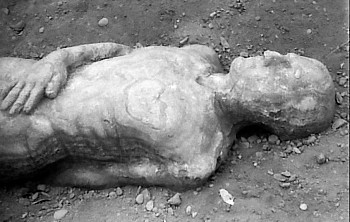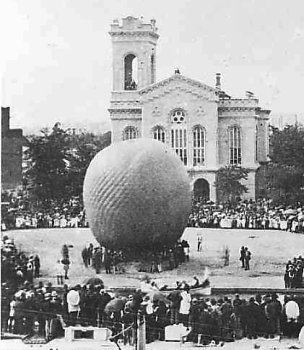Living in Oz's Many SettingsEvents found in "The Wonderful Wizard of Oz" were likely inspire by L. Frank Baum's Boyhood in Central New York. June 5, 2003 by Sue Ferrara Can a reader of L. Frank Baum's most famous American fairy tale, "The Wonderful Wizard of Oz," find glimpses of Central New York in his book?
Indeed. Most writers and storytellers would readily admit that life experiences have a way of creeping into a story, and Baum's Oz story is a case in point. From the yellow brick road, to the Wizard himself, a careful reader who knows local history will find several shadows of Baum's 19th century life in Upstate New York. The annual OzFest celebrates the fact that Baum was born in Chittenango on May 15, 1856. Benjamin Baum, the author's father, ran the Baum Barrel Factory with his brothers, Adam Clark and Lyman Spaulding. The factory, and the Baum home, sat on what is now Route 13 in Chittenango. As a child, I spent many summer days lazing at my grandmother's home in Chittenango. While researching my book on Baum's family, I learned that I had often played at his Chittenango home, which was then owned by my grandmother's best friend. What I remember most about Chittenango is the lush green hills that surround the village. I especially loved the view while coming over the crest of Route 173 from Manlius to Chittenango.
What a careful reader can find in "The Wonderful Wizard of Oz," however, are events and experiences that occurred during Baum's adolescent years when he lived in what is now Mattydale. In 1866, Baum's parents purchased an estate outside of the city of Syracuse where they would move to in 1868, just as the author was entering adolescence. It is here, at Roselawn, that Baum seemed to begin learning his craft and storing his experiences for use later in his first Oz adventure. Two fires destroyed the home at Roselawn in the 1950s. Action Sports and Skate Center is now located on the site of the former Roselawn home on Brewerton Road (Route 11). Those experiences, or influences, that seemingly appear in "The Wonderful Wizard of Oz" include the gardens of Roselawn; the plank road; the Cardiff giant; and Professor C.C. Coe. Baum also began to learn the joys of writing and publishing at his family's new country home.
An 1853 newspaper story about the nursery noted that the nursery greenhouse contained "a large number of cuttings of rose lately introduced to this section by these enterprising gentlemen called the Augusta Rose." This new variety of rose was yellow, and again, was nurtured on the grounds around Roselawn. On Nov. 10, 1866, Benjamin and Cynthia Baum purchased 3.75 acres of the 114 acre parcel for $5,000. Family lore says that Cynthia named the estate Roselawn because of the glorious rose bushes around the property. Those rose bushes and the fruit trees, so tenderly nourished by Smith, Thorpe and Hanchett, seem to come alive in Baum's writing. In "The Wonderful Wizard of Oz," when Dorothy lands "in the midst of a country of marvelous beauty," the beauty is described this way: There were lovely patches of green sward all about, with stately trees bearing rich and luscious fruits. Banks of gorgeous flowers were on every hand, and birds with rare and brilliant plumage sang and fluttered in the trees and bushes. A little way off was a small brook, rushing and sparkling along between green banks. The location of Roselawn apparently had an impact on Baum, too. The estate stood "about one half mile from the first toll gate on the Centreville Road," according to an 1885 press clip from the Syracuse Herald. The Centreville Road was the first plank road built in the United States. The road had wooden planks only on the west side, and those planks were made of hemlock. The building of this road was quite an achievement in its time and played an important role in Syracuse's salt industry. The plank road, which ran right in front of Baum's house, extended more than 16 miles running from Syracuse north to Central Square, and cost about $1,500 per mile to construct. The total cost of the project was about $25,000. A reporter writing for the Onondaga Standard in 1847 noted of the plank road, "it is decidedly the most agreeable road to ride over that we ever saw."
The house at Roselawn was wrapped in wide porches, places where Baum reportedly loved to read. The estate provided many happy moments for the Baum family. Here, brothers L. Frank and Harry published their juvenile newspaper known as the Roselawn Home Journal. Publishing a newspaper was a common activity for children during the 1870s, and press associations sprouted on both a state and national level. In New York state, juvenile journalists could join the Empire State Press Association which was formed in 1873, and held its first convention at City Hall in Syracuse on Aug. 26, 1873. The Press Association Convention was presided over by William A. Fiske, one of a number of Syracuse-based amateur journalists who was active in the state association. Fiske published a paper called Our Gem, along with Charles Reginal Sherlock. In 1870, Sherlock had published a paper called The Empire with friends Thomas Gold Alvord, son of the lieutenant governor, and Eugene B. McClelland. Sherlock eventually became the editor of the Syracuse Courier in 1875 at the age of 17. He later worked as the managing editor of the Syracuse Standard. The Roselawn Home Journal contained stories, poems and other prose written by Baum or a member of his family. Baum and his younger brother initially printed their newspaper on a Novelty printing press, purchased by their father, Benjamin. They later upgraded their press to a Young America Press that Baum loved. He even took the time to write a letter to the Adams Press company to extol the virtues of his new printing press. The July 1871 issue of the Roselawn Home Journal carried a most important piece written by Baum titled "The True Origin of the Cardiff Giant." In 1869, George Hull, a cigar manufacturer from Binghamton, decided to have a giant created out of gypsum, and had that giant buried on a farm in Cardiff, just south of Syracuse.
The "discovery" of the giant captured people's imaginations, especially since it measured "12 feet by 22 inches," according to a news story in the Syracuse Standard. The giant's body was eventually displayed in Syracuse and when the time came to send the giant to Albany, Benjamin Baum, L. Frank's father, was one of a number of Syracuse business people to sign a petition demanding the body remain in Syracuse. The influx of tourists to see the giant had been a boon for local business. The giant must have been the talk around Roselawn, too, because the piece "The True Origin of the Cardiff Giant," is a nine-stanza poem that claimed the giant had drown during the floods that covered the earth, despite an attempt by Noah to reason with the giant. Readers of "The Wonderful Wizard of Oz," I believe, can see the influence of the Cardiff Giant hoax in a passage from the book: (W)hat interested Dorothy the most was the big throne of green marble that stood in the middle of the room. It was shaped like a chair and sparkled with gems, as did everything else. In the center of the chair was an enormous head without a body to support it or any arms or legs whatever. There was no hair upon this head, but it had eyes and a nose and mouth, and was much bigger than the head of the biggest giant. "I am Oz, the Great and Terrible." What is the Wizard of Oz, but a great hoax the size of the Cardiff Giant? And, that hoax of a wizard makes his escape in a hot air balloon, another scene that probably has roots in a 19th century Central New York event.
In 1871, Professor C.C. Coe, of Rome, brought his hot air balloon, called the New World, to downtown Syracuse for a race. In this race, the person traveling the greatest distance would claim a $500 prize. Coe's balloon had a length of 120 feet and a capacity of 95,500 cubic feet. In pictures from the Onondaga Historical Association collection, the balloon seems to dwarf Syracuse's tallest buildings at the time. Hundreds of people were gathered in Clinton Square to witness the event. High winds blew through Clinton Square in downtown Syracuse on that September 1871 day, and Coe's challenger decided to stay on the ground. But the lack of a challenger and high winds did not deter Professor Coe from making a flight eastward. A report described it this way: After tangling the basket in telephone wires, the balloon was got over them, then collided with the Kimber Block just north of the Warren Street canal bridge ... Finally the monster was over Clinton Square, swaying one way then the other, as if uneasy ... The rope was cast off, and up, up, went the great air ship, keeping almost over its starting point until an altitude of near two miles was reached, when a southeasterly current was struck and away went the voyagers, passing villages and rising above the clouds to catch a view there that none but balloon passengers ever see. The flight ended in Oneida where Professor Coe's passengers, Edward B. Griswold, Charles D. Smith and George C. Becker hopped a train back to Syracuse. There are actually two passages in "The Wonderful Wizard of Oz" that refer to hot air balloons. Every one knows that Dorothy is to return to Kansas with the Wizard in a hot air balloon. However, missing Toto, Dorothy goes looking for her dog. After finding Toto, Dorothy races to the balloon and is nearly in the basket when "crack! went the ropes, and the balloon rose into the air without her." She calls for the Wizard to return and of course, he can't. Earlier in the story, when Dorothy discovers that the Wizard of Oz is a mere mortal, the Wizard tells Dorothy that he is from Omaha. He tells her that he was a balloonist in the circus, and that one day the "the ropes got twisted" and he couldn't come back to earth. "For a night and a day," the Wizard tells Dorothy, "I traveled through the air, and on the morning of the second day I awoke and found the balloon floating over a strange and beautiful country." And the beautiful country Baum wrote of so lovingly must have been Central New York. Five years after the family moved to Roselawn, the author's father began to suffer from health problems. Financial problems apparently followed and Roselawn, the family's beloved home, went up for auction on March 11, 1880. L. Frank Baum purchased the house, while a member of the famous Syracuse Crouse family bought most of the land around the estate. Baum owned Roselawn until 1883. By then, Baum was married to Maud Gage and living in Syracuse. He and Maud were expecting their first child. Baum's mother purchased the house from her son for $1. She sold Roselawn on Sept. 24, 1887, seven months after the death of her husband. Baum ultimately left Syracuse in 1888, moving with Maud and their children to Aberdeen, S.D. But clearly Roselawn, and selected events during Baum's life, infused the author's works. He never forgot his days at Roselawn, which were clearly some of his happiest and most settled times. And maybe this is why when the Scarecrow asks Dorothy why she would want to leave the beauty of Oz to return to Kansas, Dorothy replies: "No matter how dreary and gray our homes are, we people of flesh and blood would rather live there than in any other country, be it ever so beautiful. There is no place like home." Sue Ferrara is author of "The Family of the Wizard: The Baums of Syracuse." She now lives in Princeton, N.J. © 2003 The Post-Standard. Road Goes On and OnA Syracuse woman is extending the Chittenango Yellow Brick Road to Little Italy and beyond.Sunday, May 16, 2004 by Aaron Gifford, Staff writer Kathleen Sorbello Di Scenna hosted the grand opening of her Land of Oz Preservation Company on Saturday at 415 N. Salina St., Syracuse. It's a resource center dedicated to Wizard of Oz author and Central New York native L. Frank Baum. "I wanted to concentrate on the life of L. Frank Baum in Syracuse," said Di Scenna, who, like Baum, was born in Chittenango and later moved to the city. She would like to see Syracuse embrace its Oz heritage as Chittenango has. The Madison County village is the site of an annual OzFest that draws thousands of visitors and has a yellow brick sidewalk through its downtown, an Oz museum and several Oz-themed businesses, like the OzCream parlor, the Emerald City Grill and the Land of Oz and Ends. Baum moved to Syracuse at the age of 5 after his father made a fortune in the oil business. The Baums opened several businesses in Syracuse, Di Scenna said, including a bank. The Baums owned a dry goods store in what is now the Syracuse Suds Factory on South Clinton Street and another business in Armory Square where Hendricks Photo Supply is, Di Scenna said. The family's Syracuse home at "1 Rust Street" is now the Dollar Store on Midland Avenue, she added. "There are 14 books of Oz and 300 characters," Di Scenna said. "It's time we learned more about the man who did this. We live where he lived." Di Scenna eventually wants to organize Oz children and family events in Syracuse and sell merchandise. She dreams of opening an Oz Theme park in Central New York someday. Di Scenna, who works at her mother-in-law's Di Scenna Travel Service, will run a "Follow the Road of Yellow Brick" bus tour on June 6. It stops at Baum's birthplace in Chittenango, the Fayetteville home where he married Maud Gage in 1882 and the house of his grandparents in New Woodstock, which is now the Stanton Bed and Breakfast. She said she's planning a re-enactment of Baum's introduction to Gage, which took place at what is now 678 W. Onondaga St. Di Scenna, who is a big fan of the books and the movie, said adults and children alike are eager to learn about Baum because his work influenced other great writers, including Harry Potter creator J.K. Rowling. John W. Di Marco and Faith Groesbeck, both 11, said they learned "a ton" about Baum on Saturday. Both have seen the "Wizard of Oz" movie several times and plan to attend next month's OzFest in Chittenango. Di Marco, who sported a scarecrow costume, said the 1939 classic was way ahead of its time. He was astonished to learn that Baum made four of his own movies before MGM's production. "When I was little, I couldn't watch the whole thing," Di Marco said, adding that he has watched "The Wizard of Oz" video "too many" times, but never saw it on a big screen. "Whenever the witch came out, that's when I went to get chocolate chip cookies." © 2004 The Post-Standard. |
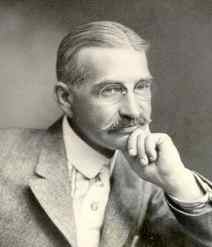
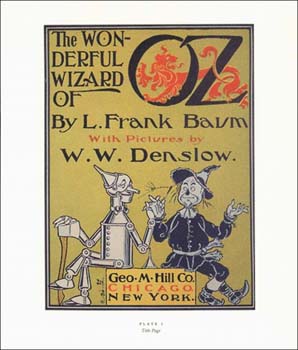 Finding
Chittenango in Baum's book is problematic. Baum left Chittenango at the age
of 4 1/2, when his mother bought a home on 1 Rust St. in Syracuse. But Baum
returned to Chittenango as a young adult many times. If I could interview
Mr. Baum, however, my first question would be: Was the Emerald City created
out of your memory of the green hills of Chittenango?
Finding
Chittenango in Baum's book is problematic. Baum left Chittenango at the age
of 4 1/2, when his mother bought a home on 1 Rust St. in Syracuse. But Baum
returned to Chittenango as a young adult many times. If I could interview
Mr. Baum, however, my first question would be: Was the Emerald City created
out of your memory of the green hills of Chittenango? 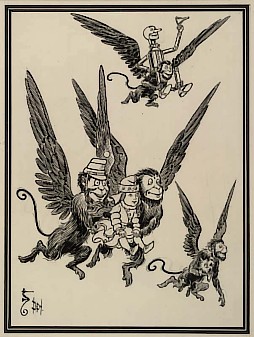 The
story of Roselawn begins with three nursery men who purchased 114 acres of
contiguous land between 1854 and 1866. The nursery firm Smith, Thorpe and
Hanchett was known in Syracuse for its numerous varieties of fruit and
ornamental trees. At the 1852 New York State Fair, the company boasted "88
varieties of pears, 35 varieties of apples, and 20 of plum." All these trees
were grown on the land around Roselawn.
The
story of Roselawn begins with three nursery men who purchased 114 acres of
contiguous land between 1854 and 1866. The nursery firm Smith, Thorpe and
Hanchett was known in Syracuse for its numerous varieties of fruit and
ornamental trees. At the 1852 New York State Fair, the company boasted "88
varieties of pears, 35 varieties of apples, and 20 of plum." All these trees
were grown on the land around Roselawn. 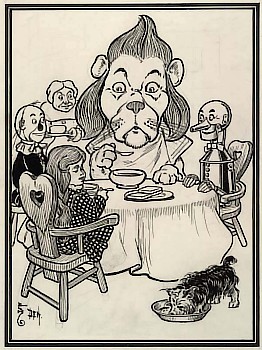 That
the plank road played a pivotal role in the lives of Central New Yorkers is
without dispute. The fact that Baum lived on the road as a teenager must
have left an impact on him. But what really ties the plank road to road so
key in "The Wonderful Wizard of Oz" is the hue of the planks. The hemlock
planks were golden-colored.
That
the plank road played a pivotal role in the lives of Central New Yorkers is
without dispute. The fact that Baum lived on the road as a teenager must
have left an impact on him. But what really ties the plank road to road so
key in "The Wonderful Wizard of Oz" is the hue of the planks. The hemlock
planks were golden-colored. 